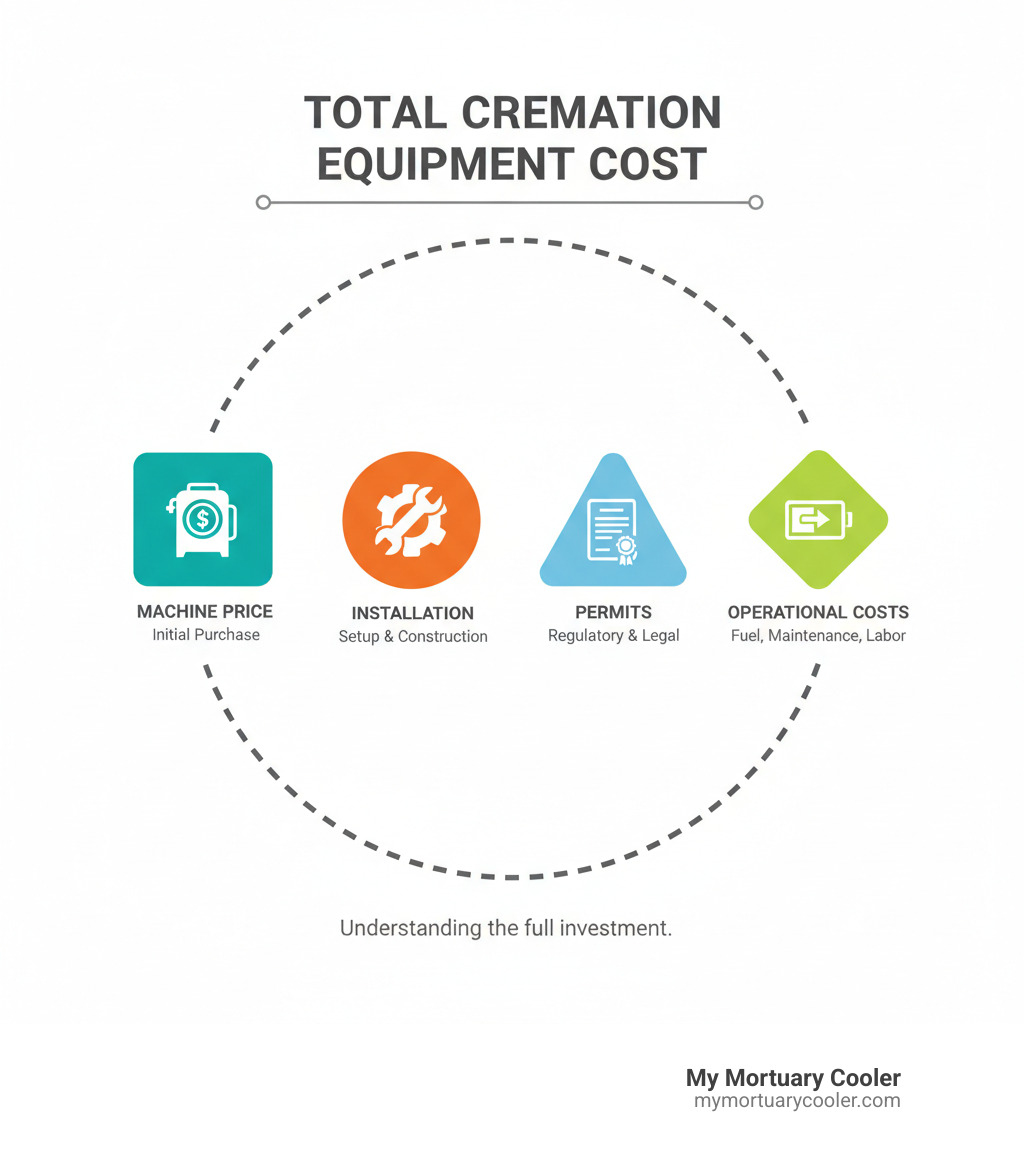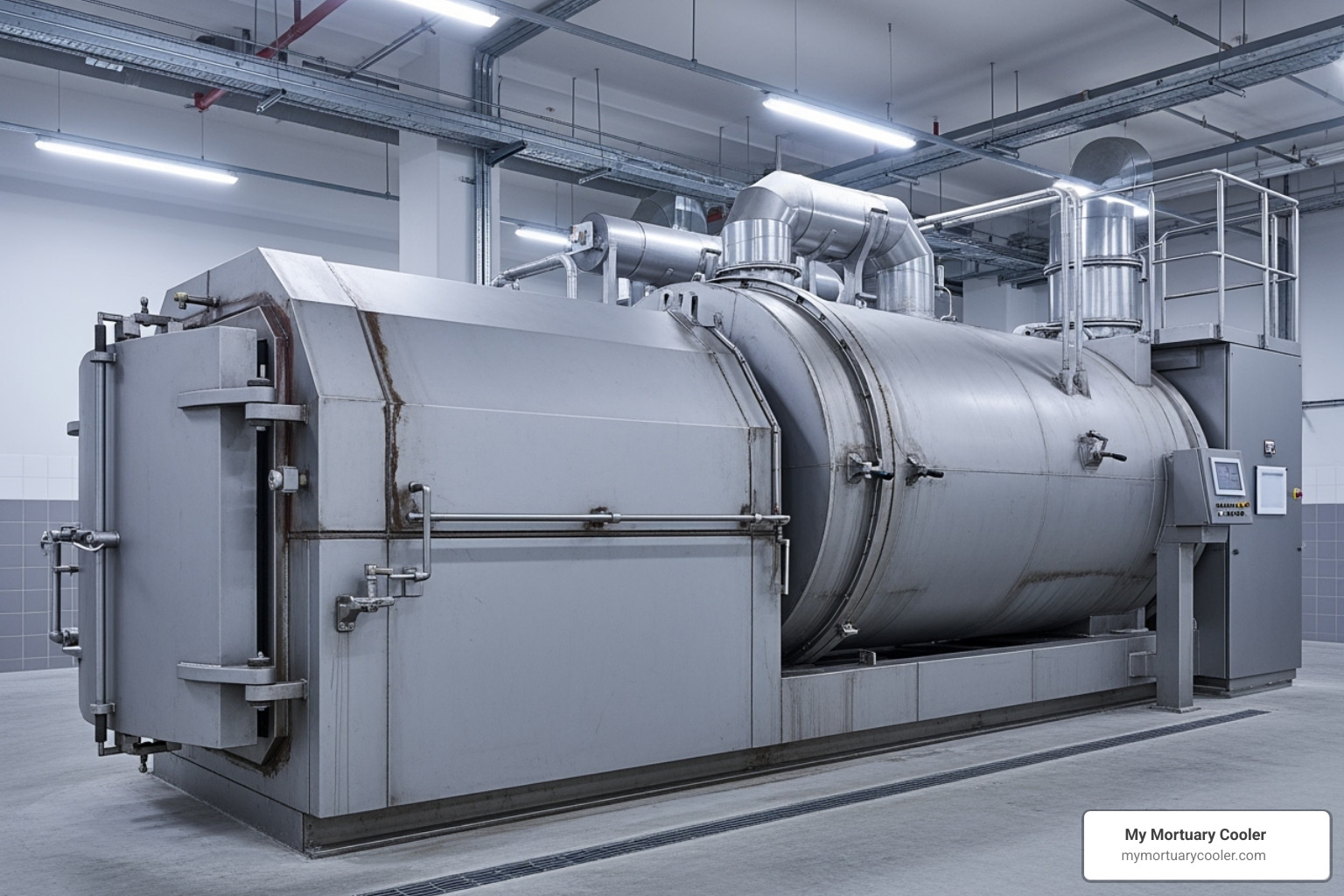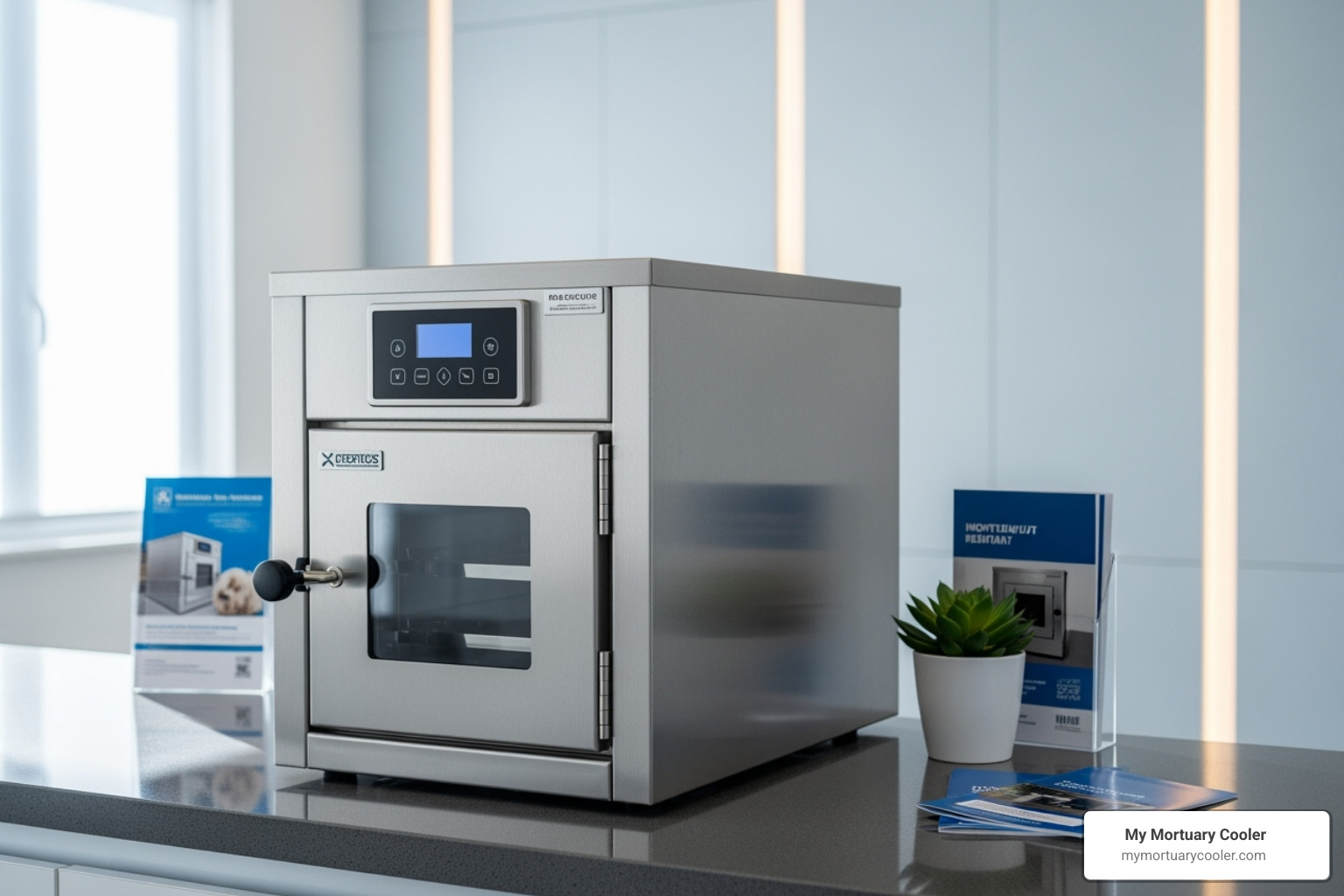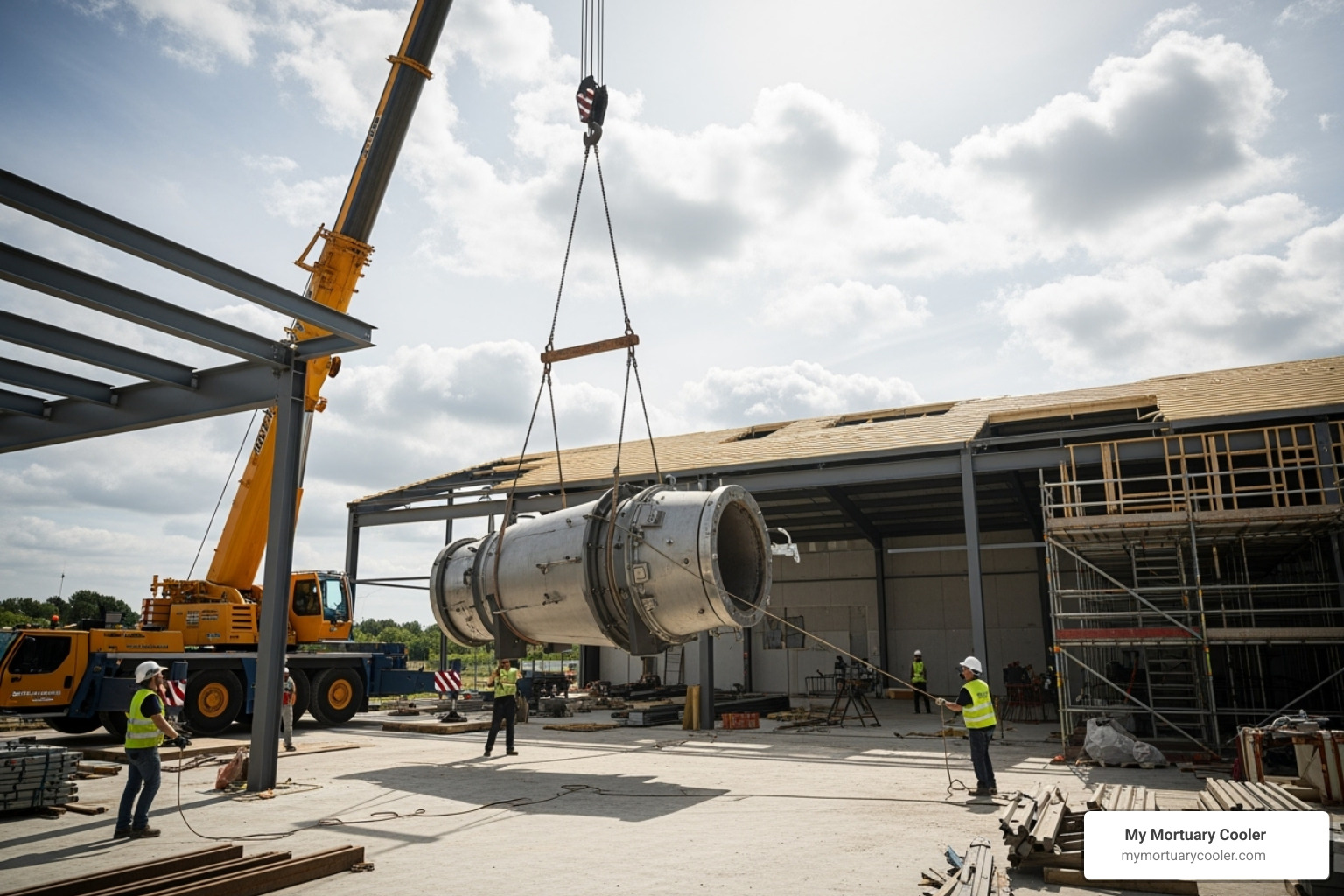Understanding the Investment: Cremation Equipment Cost Demystified
For funeral industry professionals, understanding the true cremation equipment cost goes beyond the sticker price.
Here's a quick overview of typical price ranges:
- Human Cremation Retorts: Start around $170,000 for the basic retort only. A full, operational setup can cost $300,000 to $500,000+.
- Pet Cremation Units: Range from $2,000 for entry-level models to over $229,900 for large-capacity systems.
- Aquamation Machines: Typically priced between $209,900 and $329,900+.
- Total Crematorium Startup: Expect overall costs to range from $274,000 to $1,637,500. This includes equipment, installation, permits, and facility setup.
With the U.S. cremation rate growing, investing in this equipment is a major business decision that requires careful planning.
Your total investment is significantly impacted by installation, permits, and ongoing operational costs. As one funeral director shared, "The retorts themselves are around $170k, but then you have all the construction costs and permitting which ranges a lot."
This guide breaks down the costs for human and pet cremation units, as well as alternatives like aquamation, to help you make a smart investment.

Decoding the Price Tag: Human vs. Pet Cremation Equipment
The initial purchase price is the starting point for your cremation equipment cost. This investment is shaped by whether you plan to offer services for humans or pets.
Average price range for human cremation machines
A basic human cremation retort starts around $170,000, but this is just the core machine.

A complete, operational setup typically costs $300,000 to $500,000. This figure includes the retort, delivery, installation, utility hookups, and permits. As one sales representative shared, "about $350,000 for everything, including the retort and installation," for a facility in North Texas. This higher price reflects the cost of integrating the machine into a working facility.
Top-of-the-line systems with advanced features, higher capacity, and better efficiency can easily exceed $500,000. Their higher cremation equipment cost is due to benefits like improved automation and advanced emissions control.
Price is influenced by the machine's capacity, processing rate, materials, and technology. Choosing the right machine requires balancing your budget with your business needs. To learn more about these numbers, take a look at our guide on The Real Cost of Cremation Machines Revealed.
Average price range for pet cremation machines
Pet cremation equipment has a wide price range, from small units for individual pets to large, high-volume systems.

Entry-level units cost between $2,000 and $5,000. These smaller, often imported units are suitable for low-volume needs, like a vet clinic's in-house service, but it's wise to consider their limitations in capacity, durability, and support.
Mid-size units, ideal for many pet crematories, range from $55,000 to $99,000. A medium-size cremator might be priced at $55,000. Specific models for pets up to 100lb cost around $59,900, while larger multi-compartment units for pets up to 550lb can be $99,900. Other proven mid-range systems can be found for around $21,700, offering a solid option for many businesses.
Full-scale or high-volume units for large animals or communal cremations range from $179,000 to over $220,000. For example, a stationary unit for animals up to 2,500lb costs $179,900, while a mobile unit for up to 4,000lb is $229,900. These often have multiple compartments to increase throughput.
Choosing between single-chamber and multi-chamber systems affects price and capability. Multi-chamber units cost more but offer greater flexibility and volume, making them ideal for growing businesses. To dive deeper into what might be best for your specific needs, our guide on Choosing the Right Pet Cremation Machine Made Easy offers even more insights.
Key Factors That Drive Cremation Equipment Cost
The sticker price is just the tip of the iceberg. To understand the full cremation equipment cost, you must consider key factors that influence your initial investment, long-term performance, and operational expenses.
1. Capacity, Processing Rate, and Fuel Type
A machine's capacity (pounds handled) and processing rate (pounds per hour) are primary cost drivers. The fuel type—natural gas, propane, or electric—also significantly impacts both upfront and ongoing costs. The combustion technology, such as hot-hearth vs. cold-hearth designs, affects efficiency and price. For more details on these choices, check out our guide on From Purchase to Pyre: Finding the Right Cremation Incinerator for Sale.
2. Automation, Emissions, and Brand Origin
The level of automation, from manual loading to remote diagnostics, affects the price but can improve efficiency. Advanced emissions control systems are essential for EPA compliance and add to the cost. You can find more information about regulations on sites like sam.gov. Finally, brand reputation and origin are crucial; American-made equipment often provides a better total cost of ownership due to superior parts availability and support compared to cheaper imports.
3. The Aquamation Alternative: A Different Kind of Cremation Equipment Cost
Aquamation (alkaline hydrolysis) is a flameless alternative gaining popularity. The equipment cost is $209,900 to $329,900+, but the total investment includes unique utility requirements (water, chemicals), different permitting processes, and considerations for consumer perception in your market. You can dive deeper into comparing these systems in our guide, The Ultimate Guide to Comparing Alkaline Hydrolysis Equipment.
1. Capacity, Processing Rate, and Fuel Type
Three key factors shape your cremation equipment cost and operations: capacity, processing rate, and fuel type.
Capacity and Processing Rate: The Heart of Your Operation
Processing rates vary by machine size: small pet units handle 75-100 lbs/hour, mid-range machines 100-200 lbs/hour, and high-volume human units 200-400+ lbs/hour. Higher rates mean a higher cremation equipment cost.
Pet crematories can benefit from multi-compartment designs that process several animals at once, increasing efficiency and revenue potential, whereas human cremation requires single-body systems.
Fuel Source: Your Long-Term Partner
The fuel your machine uses impacts your ongoing operational costs. Each type has its own advantages.
Natural gas is the most common and economical fuel, costing $0.50 to $1.00 per hour. A typical human cremation uses 12.5 to 18 therms.
Propane (LPG) is an alternative where natural gas is unavailable. A smaller unit uses 7 to 11 gallons per hour, but fuel costs can fluctuate.
Electric systems are a specialized option, with costs dependent on local electricity rates.
Combustion Technology: Where Engineering Meets Efficiency
The cremator's combustion system impacts performance and price. The choice between hot-hearth and cold-hearth designs is important.
Hot-hearth designs maintain heat between cycles for faster, more fuel-efficient cremations. They have a higher initial cremation equipment cost but lower operational expenses than cold-hearth designs, which cost less upfront but use more energy per cycle.
Advanced hot-hearth designs, including recessed and modular options, offer superior efficiency, justifying their premium price.
For a comprehensive look at various systems and how these factors come together, explore our guide on From Purchase to Pyre: Finding the Right Cremation Incinerator for Sale.
2. Automation, Emissions, and Brand Origin
Beyond core functions, features like automation, emissions control, and brand origin significantly impact the cremation equipment cost and your operational experience.
Level of Automation
Automation adds convenience and efficiency, but also increases the price tag.
- Manual vs. Automatic Loading: Automated loading systems, like a "Flex 180 Autoloader" or "Auto Charger - AC-1," cost $15,799 to over $35,304 but reduce physical labor and increase speed.
- Remote Diagnostics: High-end units allow technicians to diagnose issues remotely, saving on service calls and minimizing downtime, making the higher upfront cremation equipment cost a wise investment.
- Touch-Screen Controls: Modern touch screens simplify operation and provide real-time data, adding to the cost but improving daily workflow.
Emissions Control Systems
Robust emissions control is essential for modern crematoriums.
- EPA Compliance: Equipment must meet strict Environmental Protection Agency (EPA) standards. Advanced afterburners, filtration, and monitoring systems add to the cremation equipment cost but are essential for obtaining and keeping operating permits. To stay up-to-date, you can check the latest regulations on emissions.
Brand Origin and Reputation
Where your equipment comes from and who made it affects price and long-term value.
American-Made Equipment: While the initial cremation equipment cost may be higher, American-made units typically offer superior quality, easier access to parts, and reliable support. This leads to a lower total cost of ownership. As one funeral director noted, avoiding imported units can prevent issues like language barriers during critical support calls. At My Mortuary Cooler, we're proud to supply professional-grade, American-made products that are built to last.
-
Imported Equipment: Imported units may be advertised for as little as $13,999 to $65,000, but hidden costs can quickly eliminate savings.
- Shipping and Duties: Ocean freight can add $5,000 to $10,000.
- Compliance Modifications: Modifications to meet U.S. standards can cost $20,000 to $50,000.
- Parts Availability: Sourcing replacement parts can be slow and expensive, leading to costly downtime.
- After-Sales Support: Language barriers and time zone differences can make technical support difficult.
Total Cost of Ownership
Consider the total cost of ownership, which includes purchase price, installation, maintenance, and potential downtime. A domestic unit's reliability, support, and longer lifespan (15+ years) often make it more economical long-term than a cheaper import.
3. The Aquamation Alternative: A Different Kind of Cremation Equipment Cost
Aquamation, or "water cremation," is a popular alternative to flame cremation with its own unique cremation equipment cost considerations.
Alkaline Hydrolysis Definition: Aquamation is a flameless process using water, alkaline chemicals, pressure, and heat to accelerate natural decomposition. The body is placed in a stainless steel vessel and reduced to bone fragments and a sterile liquid. It is often considered a greener alternative to flame cremation.
Equipment Cost: The cremation equipment cost for an aquamation machine starts around $209,900 and can exceed $329,900 for advanced models. This price typically excludes freight, training, and utility hookups, which are additional expenses.
Utility Requirements: Aquamation has unique utility needs, including significant water usage (80-300 gallons per case) and recurring chemical costs. The liquid byproduct (effluent) must be handled according to local regulations, often requiring specialized drainage and wastewater systems that add to installation costs.
Permitting Differences: As a newer technology, aquamation regulations vary significantly by location. Some states have not yet approved it. Securing permits can be more complex and expensive than for traditional cremation due to its unique environmental considerations.
Consumer Perception: While aquamation appeals to a niche market, broader consumer awareness and demand may be lower than for flame cremation. One funeral director noted receiving "zero requests for green alternatives" over 10 years. This potential for slower adoption should be factored into your ROI calculations.
When comparing aquamation to traditional cremation, it's crucial to weigh the higher upfront investment and specialized infrastructure against potential environmental advantages and evolving consumer preferences. For an even closer look at these systems, be sure to check out The Ultimate Guide to Comparing Alkaline Hydrolysis Equipment.
Beyond the Machine: Uncovering the Total Investment
The cremation equipment cost extends far beyond the machine's price. A significant portion of your budget is for getting the crematorium operational. Budgeting for these additional expenses is crucial to avoid being blindsided.
Additional Startup and Installation Costs
Getting from machine delivery to the first cremation involves several crucial and expensive steps.

- Delivery: Domestic shipping costs $5,000 to $15,000. Imported units add $5,000 to $10,000 for ocean freight, plus customs fees.
- Rigging and Crane Operations: Positioning the heavy machine requires crane services ($2,000 to $5,000) and a specialized rigging crew.
- Contractors: Licensed electricians are needed for power hookups ($3,000 to $10,000), and plumbers for gas lines ($5,000 to $15,000).
- Ventilation and Stack Installation: Legally required ventilation and stack systems add $10,000 to $25,000 to your costs.
- Foundation Work: A reinforced foundation to handle the machine's weight and vibration can cost $5,000 to $20,000.
Total installation costs can bring the full investment to $300,000 to $500,000, including the machine. A complete setup with a new building can cost around $270,000 (e.g., $120,000 building, $150,000 equipment), showing the machine is just one part of the financial puzzle.
For detailed guidance on planning your facility layout and infrastructure, our Crematory Facility Design Considerations guide offers valuable insights.
Permits, Zoning, and Ongoing Operational Costs
Navigating permits and regulations is essential for legal operation and public safety.
- EPA Permits: Ensuring air quality standards costs $5,000 to $20,000.
- Zoning Approvals: Securing proper zoning can cost $2,000 to $15,000 and may involve public hearings.
- Building Permits: Facility modifications typically require permits costing $1,000 to $5,000.
- Environmental Impact Studies: May be required in some areas, adding $5,000 to $25,000.
Location is critical, as state and local rules on zoning, stack height, and waste disposal vary. These differences impact the complexity and cost of permits.
Ongoing operational expenses include:
- Fuel Consumption: This is often the largest recurring cost. Natural gas can cost $13.00 to over $40.00 per cremation. Propane units might use 10.5 to 16.5 gallons per 90-minute cycle.
- Maintenance Contracts: While not always mandatory, service contracts are a wise investment to extend warranty and prevent costly downtime.
- Labor Costs: Salaries for trained operators are a significant expense.
- Ancillary Supplies: Budget for cremation containers, temporary urns, cleaning supplies, and PPE.
- Utilities and Rent/Mortgage: Monthly operating expenses, including electricity and facility payments, typically range from $5,000 to $10,000.
To help you steer these complex financial considerations and develop a comprehensive business plan, consider downloading the Ultimate Funeral Business Plan Template.
Calculating Your Return on Investment (ROI)
A cremator is a revenue-generating asset, not just an expense. Calculating your Return on Investment (ROI) helps project when you will recoup your initial cremation equipment cost and begin turning a profit. With growing demand, many find the equipment pays for itself faster than expected.
Estimated ROI for a Pet Cremator
Investing in a pet cremator can offer impressive returns in this growing market. Here are some financial projections:
- Mid-Size Pet Cremator Example: With a unit price of $55,000, you could see an annual net profit of $32,760 (based on $90,720 in sales and $45,360 in operating costs). The estimated payback period is about 5 years.
- Full-Scale Pet Cremator Example: With a unit price of $220,000, the potential annual net profit is $176,840 (based on $445,680 in sales and $222,840 in operating costs). The payback period is also around 5 years, thanks to higher volume.
Some operators report even faster returns. One owner paid off a $21,700 system in about five years with just one cremation daily at $180 per service, showing that even modest volume generates solid returns.
While larger units have a higher initial cremation equipment cost, their increased revenue potential can lead to similar payback periods and greater overall profitability.
Estimated ROI for a Human Cremator
The ROI for human cremation equipment is also compelling, depending on your operational scale and market.
Case volume is crucial. A facility performing 300 cremations per year is often considered high-volume.
Revenue per cremation ranges from $400 to $1,200, depending on the service package and local market.
The payback period can be quick. A high-volume facility could recover a $500,000 investment in just 2-3 years. Smaller operations typically see a return in 5-7 years.
Your initial cremation equipment cost can be recouped rapidly with effective management. One funeral director reported their crematorium became their most profitable service line within three years.
A robust business plan is essential to project volume, revenue, and costs, providing a clear roadmap to ROI and ensuring your investment is a strategic success.
For a comprehensive overview of the total investment landscape, visit our detailed guide: How Much Does A Crematorium Cost? | My Mortuary Cooler.
Frequently Asked Questions about Cremation Equipment Cost
Here are answers to common questions about the investment behind cremation equipment cost.
How much does a complete human crematorium setup really cost?
A basic human cremation retort may start around $170,000, but this is just the machine. A complete, operational setup typically costs $300,000 to $500,000. This all-inclusive price covers the retort, delivery, professional installation (gas, electrical), crane services, and all necessary EPA permits and zoning fees. These additional costs can range from $130,000 to $330,000 depending on your location and facility, so it's crucial to budget for them.
Are cheaper imported machines a good long-term investment?
Imported machines advertised for as low as $13,999 to $65,000 seem tempting, but they often lead to a higher total cremation equipment cost. Hidden expenses include international shipping ($10,000-$20,000), costly modifications (up to $50,000) to meet U.S. standards, and significant downtime due to unavailable parts and difficult technical support. This "penny-wise but pound-foolish" approach makes American-made equipment, with its reliable support and parts availability, a more economical long-term investment. At My Mortuary Cooler, we believe in providing professional-grade, American-made products that stand the test of time and support your business without the hidden surprises.
What are the biggest ongoing costs of running a crematorium?
The largest ongoing costs for a crematorium are fuel, electricity, and routine maintenance. Fuel costs can range from $13 to over $40 per cremation, depending on the unit's efficiency and local prices. Electricity powers control systems and fans. A comprehensive maintenance contract is a crucial expense that ensures longevity, efficiency, and compliance, preventing costly breakdowns. Operator salaries are also a significant part of the ongoing budget.
Conclusion
Understanding cremation equipment cost requires seeing the full picture, from the initial $170,000 retort to a $500,000 complete setup. The key takeaway is that the cheapest upfront option, like an imported machine, is rarely the wisest long-term investment and can lead to expensive problems.
Key factors like capacity, fuel type, automation, and emissions control are the foundation of your business's success. An efficient, compliant machine with reliable support is a far better investment than a low-cost unit that causes future issues.
Hidden costs like installation, permits, and ongoing fuel expenses can double your initial investment. Proper planning turns these into manageable steps toward profitability.
The ROI is exciting, with a mid-size pet cremator showing $32,760 in annual profit potential and human cremators paying for themselves in a few years. This equipment is an investment in serving your community.
At My Mortuary Cooler, we understand that choosing cremation equipment is about more than just numbers on a spreadsheet. It's about building a business that can serve your community with dignity and compassion for decades to come. We're committed to providing the professional-grade equipment and honest expertise you need to make that happen.
For a complete operational setup, integrating high-quality cold storage is essential. Improve your funeral home operations with our ultimate guide to mortuary freezers and morgue coolers. Because when families trust you with their loved ones, every detail matters.